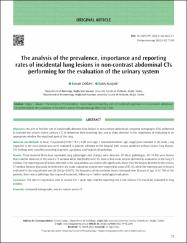The analysis of the prevalence, importance and reporting rates of incidental lung lesions in non-contrast abdominal CTs performing for the evaluation of the urinary system
Citation
Doğan E, Alaşan F. The analysis of the prevalence, importance and reporting rates of incidental lung lesions in non-contrast abdominal CTs performing for the evaluation of the urinary system. Pelviperineology 2022;41(2):73-80Abstract
Objectives: We aim to find the rate of incidentally detected lung lesions in non-contrast abdominal computed tomography (CTs) performed to evaluate the urinary system (urinary CT), to determine their reporting rate, and to draw attention to the importance of evaluating in an appropriate window the visualized parts of the lung. Materials and Methods: In total, 152 patients [50.99±18.23; 6-89 years (age ± standard deviation; age range)] were included in the study. Lung segments in the cross-section area were evaluated in patients admitted to the hospital with urinary problems without known lung disease. The findings were classified according to gender, age group, and location of pathology. Results: Three hundred thirty-four reportable lung pathologies and changes were detected. Of these pathologies, 48 (14.4%) were lesions that could be observed in the urinary CT window while 286 (85.6%) were the lesions that could only be detected by evaluation in the lung CT window. The reporting rate of lesions detected in the lung window was statistically significantly lower than the lesions detected in the urinary CT window [Lesions that could be detected in the main evaluation window were reported at a rate of 83.3%, while the reporting rate of lesions evaluated in the lung window was 20.62% (p=0.007)]. The frequency of encountered lesions increased over 50 years of age. In 67.76% of the patients, there was a pathology that required treatment, follow-up or further radiological evaluation. Conclusion: The rate of lung lesions seen in urinary CTs is quite high, and the reporting rate is low. Urinary CTs should be evaluated in lung window.


















